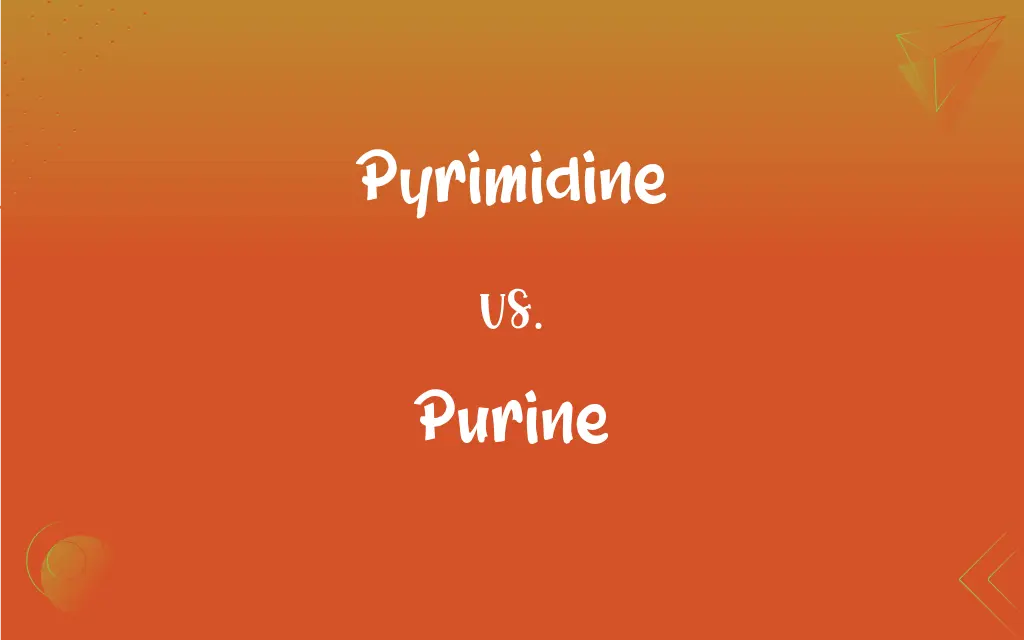Pyrimidine vs. Purine: What's the Difference?
Edited by Janet White || By Harlon Moss || Published on January 3, 2024
Pyrimidine is a nitrogenous base with a single ring structure, found in DNA and RNA. Purine is a nitrogenous base with a double ring structure, also found in DNA and RNA.

Key Differences
Pyrimidines are the smaller of the two types of nitrogenous bases in nucleic acids, having a single-ring structure. In DNA, they include cytosine and thymine, and in RNA, uracil replaces thymine. Purines, with a larger double-ring structure, include adenine and guanine in both DNA and RNA. This size difference affects how they pair in the DNA structure.
In DNA, pyrimidines pair with purines - cytosine pairs with guanine, and thymine (or uracil in RNA) pairs with adenine. This pairing is due to their structural compatibility and hydrogen bonding patterns. Purines pair with pyrimidines, maintaining the width of the DNA double helix constant.
The synthesis of pyrimidines involves a simpler process compared to purines. Pyrimidines are synthesized from basic biochemical components like aspartic acid and carbamoyl phosphate. In contrast, purines are synthesized in a more complex process, involving multiple steps and starting from compounds like ribose-5-phosphate.
In biochemical pathways, pyrimidines can be broken down to simpler compounds and used for energy or other metabolic processes. Purines, when broken down, can lead to the production of uric acid, which is excreted from the body. Excess purine metabolism can lead to conditions like gout.
Pyrimidines also differ in their hydrogen bonding capabilities. They typically form two hydrogen bonds with their complementary purines in DNA. Purines, being larger, form three hydrogen bonds when adenine pairs with thymine (or uracil in RNA) and two bonds when guanine pairs with cytosine.
ADVERTISEMENT
Comparison Chart
Structure
Single-ring
Double-ring
Types in DNA/RNA
Cytosine, Thymine (Uracil in RNA)
Adenine, Guanine
Synthesis Process
Simpler, from basic components
More complex, multiple steps
Bonding in DNA
Two hydrogen bonds
Three (with Thymine) or two (with Cytosine) hydrogen bonds
Metabolic Breakdown
Breaks down to simpler compounds
Leads to uric acid production
ADVERTISEMENT
Pyrimidine and Purine Definitions
Pyrimidine
Pyrimidine bases are essential for the structure and function of RNA and DNA.
Uracil, a pyrimidine, replaces thymine in RNA.
Purine
Purines are synthesized through a complex pathway in cells.
The synthesis of guanine, a purine, is a multi-step process.
Pyrimidine
Pyrimidine is a type of nitrogenous base characterized by a single-ring structure.
Cytosine, a pyrimidine, pairs with guanine in DNA strands.
Purine
In DNA, purines form hydrogen bonds with complementary pyrimidines.
In DNA, the purine guanine forms three hydrogen bonds with cytosine.
Pyrimidine
Pyrimidines are synthesized from simple precursors in cells.
The synthesis of cytosine, a pyrimidine, is vital for DNA replication.
Purine
A class of organic compounds, purines are key components of nucleic acids.
Guanine, a purine, is found in both DNA and RNA.
Pyrimidine
In DNA, pyrimidines form hydrogen bonds with complementary purines.
In DNA, the pyrimidine thymine forms two hydrogen bonds with adenine.
Purine
Purine is a type of nitrogenous base with a double-ring structure.
Adenine, a purine, pairs with thymine in DNA.
Pyrimidine
A class of organic compounds, pyrimidines are crucial components of nucleic acids.
Thymine, a pyrimidine, is found only in DNA.
Purine
Purine bases are fundamental to the coding, decoding, and expression of genes.
The role of adenine, a purine, is crucial in protein synthesis.
Pyrimidine
A single-ringed, crystalline organic base, C4H4N2, that is the parent compound of a large group of biologically important compounds.
Purine
A double-ringed, crystalline organic base, C5H4N4, that is the parent compound of a large group of biologically important compounds.
Pyrimidine
Any of a group of substituted derivatives of pyrimidine, including the nitrogen bases uracil, cytosine, and thymine, which are components of nucleic acids. Barbiturates and certain other drugs are also pyrimidines.
Purine
Any of a group of substituted derivatives of purine, including the nitrogen bases adenine and guanine, which are components of nucleic acids. Uric acid, caffeine, theobromine, and theophylline are also purines.
Pyrimidine
(organic compound) A diazine in which the two nitrogen atoms are in the meta- positions; it is the basis of three of the bases found in DNA and RNA: thymine, uracil and cytosine
Purine
(organic compound) Any of a class of organic heterocyclic compounds, composed of fused pyrimidine and imidazole rings, that constitute one of the two groups of organic nitrogenous bases (the other being the pyrimidines) and are components of nucleic acids.
Pyrimidine
Any of several basic compounds derived from pyrimidine
Purine
Any of several bases that are derivatives of purine
Pyrimidine
A heterocyclic organic compound with a penetrating odor
Purine
A colorless crystalline nitrogen-containing organic base; the parent compound of various biologically important substances
FAQs
Which purines are found in DNA?
Adenine and guanine are the purines in DNA.
How do pyrimidines differ structurally from purines?
Pyrimidines have a single-ring structure, while purines have a larger double-ring structure.
What is the role of purines in genetic coding?
Purines, along with pyrimidines, make up the genetic code in DNA and RNA.
What is a purine?
Purine is a nitrogenous base with a double-ring structure, also found in DNA and RNA.
What are examples of pyrimidines in DNA?
Cytosine and thymine are pyrimidines found in DNA.
What is the significance of the double-ring structure of purines?
The double-ring structure of purines allows them to pair with pyrimidines in DNA, maintaining the helical structure.
What happens to pyrimidines during DNA replication?
Pyrimidines are replicated along with purines to form new DNA strands.
What is a pyrimidine?
Pyrimidine is a nitrogenous base with a single-ring structure, important in DNA and RNA.
How do pyrimidines pair in DNA?
Pyrimidines pair with purines - cytosine with guanine, and thymine with adenine.
Can pyrimidines form hydrogen bonds in DNA?
Yes, pyrimidines form hydrogen bonds with their complementary purines in DNA.
What is the synthesis process of purines?
Purines are synthesized through a more complex pathway involving multiple steps.
Do purines have a role outside of nucleic acids?
Purines also play roles in energy transfer and cellular signaling, as in ATP and GTP.
Can purine metabolism affect health?
Yes, abnormal purine metabolism can lead to conditions like gout and kidney stones.
How does diet impact purine levels in the body?
A diet high in purine-rich foods can increase uric acid levels, affecting health.
How are pyrimidines synthesized in the body?
Pyrimidines are synthesized from simple biochemical components like aspartic acid.
How does the body handle excess purines?
Excess purines are broken down into uric acid and excreted.
Do pyrimidines directly code for amino acids?
No, pyrimidines and purines together form codons that code for amino acids.
What's the importance of pyrimidine-purine pairing in DNA?
This pairing ensures accurate DNA replication and genetic information transfer.
Are pyrimidines and purines evenly distributed in DNA?
Their distribution varies, but their pairing is always complementary to maintain DNA structure.
Are pyrimidines found in RNA?
Yes, cytosine is in both DNA and RNA, and uracil, a pyrimidine, replaces thymine in RNA.
About Author
Written by
Harlon MossHarlon is a seasoned quality moderator and accomplished content writer for Difference Wiki. An alumnus of the prestigious University of California, he earned his degree in Computer Science. Leveraging his academic background, Harlon brings a meticulous and informed perspective to his work, ensuring content accuracy and excellence.
Edited by
Janet WhiteJanet White has been an esteemed writer and blogger for Difference Wiki. Holding a Master's degree in Science and Medical Journalism from the prestigious Boston University, she has consistently demonstrated her expertise and passion for her field. When she's not immersed in her work, Janet relishes her time exercising, delving into a good book, and cherishing moments with friends and family.






































































